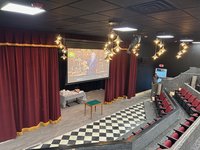The world is one step closer toward unlocking the technology to print whole organs in a lab, as scientists have succeeded in creating a 3-D biological printer that can create implantable bones, muscles and cartilage.
As Reuters reported, researchers at the Wake Forest School of Medicine in North Carolina have been able to print out small bones and other tissues and implant them into mice and rats. The process is called ITOP, for Integrated Tissue and Organ Printer.
The scientists found a solution to a key problem in bioprinting: how to create muscles or bones that absorb nutrients just like real tissue, allowing them to function normally within the body. "Microchannels" within the tissue allow the nutrients to flow in.
“It is often frustrating for physicians to have patients receive a plastic or metal part during surgery knowing that the best replacement would have been the patient’s own tissue,” Dr. Anthony Atala told Reuters. “The results of this study bring us closer to the reality of using 3-D printing to repair defects using the patient’s own engineered tissue.”
Researchers published their findings in Nature Biotechnology on Monday. Their next step: build up the technology so that they can print out more complex tissues and, eventually, entire organs.
Read the full story here.







